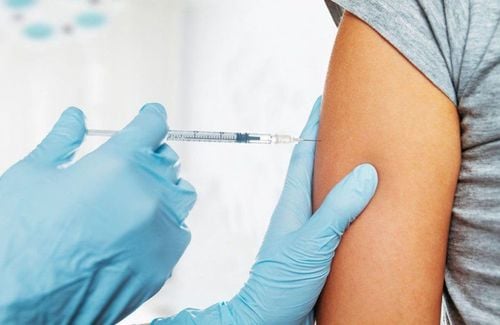This is an automatically translated article.
Anthrax, scientifically known as Bacillus anthracis, is a gram-positive bacillus. They exist in nature in the form of spores, so their existence can last for decades. Bacillus anthracis causes anthrax in both animals and humans. The human body can be infected with anthrax through different routes such as inhalation, skin, gastrointestinal tract, or needle route. The severity and symptoms of the disease depend on the route of bacterial infection.
1. What is anthrax?
Bacillus anthracis is a bacillus belonging to the family Bacillaceae, genus Bacillus. Bacillus-like bacteria are present almost everywhere in nature, including in human organs. Most of them do not cause disease, and some species even play a beneficial role, helping to balance the microflora in the human body.
Bacillus anthracis was first discovered in 1848, they are gram-positive bacilli, morphologically with two square heads, about 1 - 3 x 5 - 10 mm in size, non-motile and often arranged in chains. Bacillus anthracis easily grows in an environment with a temperature of about 37 degrees Celsius, pH = 6.9-7. Anthrax bacteria have not too high resistance, most of them are killed at 600C within 30 minutes, at 1000C within 5 minutes, and are easy to kill by common disinfectants.
When in the external environment, anthrax exists as spores. The spore form of Bacillus anthracis has very high resistance. They can exist in natural conditions for many years, even decades, and still maintain the ability to cause disease. The sporophyte is only destroyed under extreme conditions such as: dry heat of 1700C for 60 minutes or wet temperature of 1210C for 30 minutes.
Bacillus anthracis can cause disease in both humans and animals.
In animals, anthrax causes anthrax (also known as anthrax). The infected species are usually cattle, especially herbivorous cattle such as buffaloes, cows, horses, sheep,... because they easily inhale bacterial spores present in soil, grass, and water sources. infected. Most cattle infected with Bacillus anthracis die from sepsis. In humans, the bacterium Bacillus anthracis causes anthrax (Anthrax). This is an acute bacterial infection. The route of infection includes the skin route (which is the most common route, accounting for about 94-95%), the gastrointestinal tract (0.5-0.7%), the respiratory tract (0.3%). In addition, several cases have been reported in Europe that people who use needles to inject heroin have also contracted anthrax. Because of their dangerous nature and characteristics that can stay for a long time in the natural environment, in the past, anthrax bacilli have been used as biological weapons for wars and terrorism.

Ngoài con người, vi khuẩn than còn có thể gây bệnh cho động vật
2. Anthrax in humans
The main source of infection for anthrax in humans is from infected animals. Person-to-person transmission of anthrax is quite rare. Symptoms and severity of the disease vary depending on the route of infection.
Anthrax is transmitted through the skin. Anthrax spores can enter the human body through scratches or open wounds in the skin. This often happens when we come into contact with sick animals and their waste, or directly butcher animals that have died from anthrax.
Skin anthrax is the most common form of the disease, and also the least dangerous. After an incubation period of 1-10 days, the patient's skin will appear lesions. The onset is pruritus, then papules, red swellings, blisters, and about 2 to 4 days later, they develop into black necrotic ulcers. The surrounding skin is often swollen and widespread.
If treatment is carried out early and properly, the disease will heal and only leave scars on the skin. But if not treated properly or the patient's resistance is too weak, does not respond to treatment, the infection will worsen, leading to sepsis and systemic toxicity. In this case, the patient may die. This rate only accounts for about 5%, but still have to be careful.
Anthrax is transmitted through the digestive tract. When you eat raw or undercooked meat from animals infected with Bacillus anthracis, you can completely get anthrax through the digestive tract. The incubation period is usually 2 to 5 days. After that, the patient has symptoms such as: abdominal pain, loss of appetite, vomiting blood, fever, bloody stools, ... In severe cases, the patient may have toxic shock, mesenteric lymph nodes in the mesenteric lymph nodes. Enlarged intestine, mucosal damage in ileum and cecum.
Without treatment, more than 50% of patients with gastrointestinal anthrax will die. If treated promptly and properly, 60% of patients will be cured.
Anthrax is transmitted through the respiratory tract. When you breathe in the spores of the bacterium Bacillus anthracis, you can get anthrax through inhalation. This is a rare disease but the most dangerous, its mortality rate is up to 90% if not treated promptly. In the case of intensive treatment, about 55% of patients recover and survive.
After an incubation period of 1 to 5 days, the patient begins to show dangerous symptoms such as high fever with chills, cyanosis, shortness of breath, profuse sweating, headache, ... rapid illness. quickly turned to sepsis, nephritis, meningitis, systemic toxicity and patient death.

Nếu bệnh không được điều trị kịp thời, sẽ chuyển sang viêm màng não
3. How to prevent and treat anthrax
We can prevent anthrax infection by:
Anthrax vaccination should be given to animals to reduce the risk of disease outbreaks. This is a live attenuated vaccine that provides protection for about 1 year. There is also a vaccine extracted from the culture of non-encapsulated bacterial strains, which can be used in humans. However, this vaccine is usually only administered to military personnel or people with specific occupations that come into contact with animals or products containing a lot of bacteria. Animals that have died from anthrax should be properly destroyed. After deep burial of the carcass, lime should be spread closed to disinfect and prevent the spread of bacteria. Dustproof and ensure good ventilation in industrial plants, especially in the tanneries where there is a high risk of anthrax exposure. The workers here need to be fully equipped with protective clothing and equipment, often undergo periodic health checks, and immediately treat patients if disease is detected. Ensure sterilization at the final stages before bringing the product to the market. It is necessary to regularly check the source of wastewater from industrial plants, factories, and processing animal products to ensure that disease-causing bacteria are not transmitted to the outside environment. Do not trade or use the skins of animals infected with anthrax. Do not eat meat when you suspect the animal has died of anthrax. Ensure food safety, eat cooked and drink boiling. Keep the body clean, take care and pay attention to scratches or open wounds on the skin. To treat anthrax, antibiotics are the drugs used. Antibiotic treatment is highly effective if the disease is diagnosed early. Commonly used antibiotics are penicillin, tetracycline, and streptomycin. Among them, the most effective is penicillin. If the patient is allergic to penicillin or the bacteria are resistant to penicillin, a combination of antibiotics should be used for better results.
If you have unusual symptoms, you should be examined and consulted with a specialist.
Please dial HOTLINE for more information or register for an appointment HERE. Download MyVinmec app to make appointments faster and to manage your bookings easily.
Articles refer to the source: cdc.gov
MORE:
More people with Whitmore disease - precautions to take care of children with VA What is a live attenuated vaccine?













